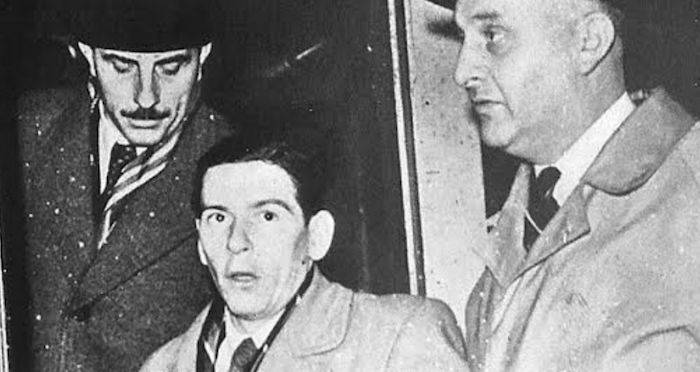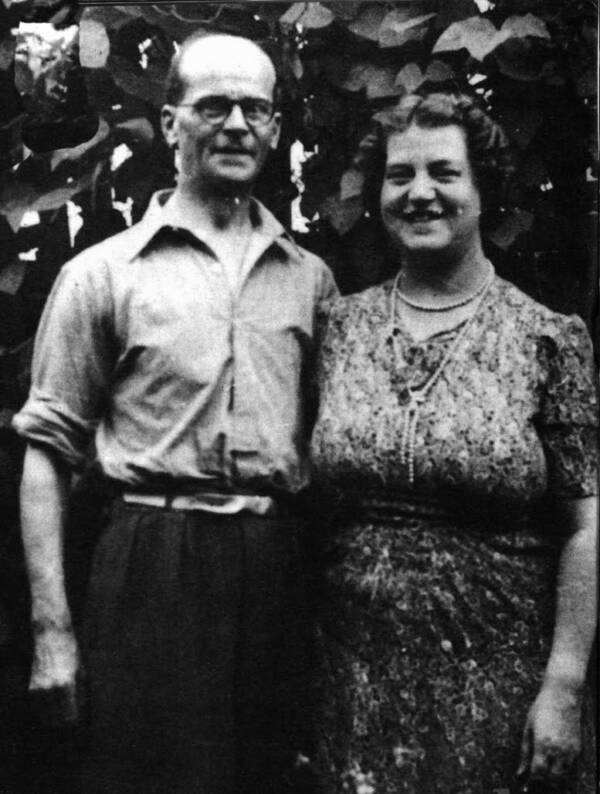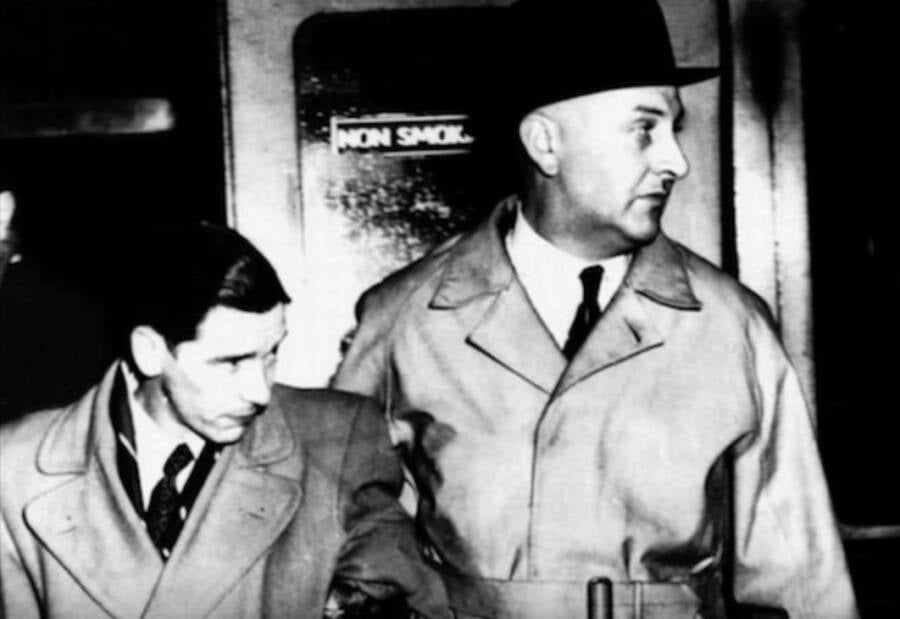
Serial killer John Christie murdered eight people starting in 1943, including his own wife — then stashed their corpses inside his London home.

Corbis Historical/Getty ImagesJohn Christie was captured for murdering eight people in 1953 — but not before letting an innocent man named Timothy Evans hang for some of his crimes.
The execution of Timothy Evans isn’t haunting because of the crime he was convicted of. It’s the fact that he wasn’t the man who did it. Charged with killing his wife and daughter, 25-year-old Timothy Evans told the court he was innocent and that it was his neighbor who lived downstairs, John Christie, that was responsible. Despite his pleas, Evans was found guilty and hanged.
Three years later, authorities discovered that John Christie was a serial killer. During his trial, he confessed to killing Evans’ wife in one of the most staggering cases of judicial failure in modern history.
This is the story of John Christie’s horrific reign of terror and how Timothy Evans paid the price for it.
John Christie’s Troubled Youth And First Forays Into Crime
John Reginald Christie was born on April 8, 1899 in Northowram, West Riding of Yorkshire, England, the sixth of seven children. His family and friends called him Reg.
Reg had a troubled childhood, often subjected to regular beatings by his father, his mother, and his older sisters. As a result, he struggled to make friends, and his lack of confidence manifested in young adulthood as sexual complications.
Christie’s sexual troubles only led to more torment, and his intimate issues would follow him into adulthood.
When he was eight years old, Christie’s grandfather passed away. Christie later cited the moment of seeing his grandfather’s dead body in a casket as life-changing. Here was a man who had scared him, now nothing more than a body. After that, Christie said corpses held a “fascination” over him.
Per the Watford Observer, Christie later enlisted in the British Army during the First World War, where he joined the 52nd Nottinghamshire and Derbyshire Regiment as an infantryman in 1918.
During the war, he was injured in a mustard gas attack and taken to a military hospital for recovery, later claiming that the attack had left him blind and mute for three years. However, as author Ludovic Kennedy later wrote in his book on Christie, Ten Rillington Place, there are no records to indicate that Christie had in fact gone blind, and that if the gas attack had left him in such poor condition, he would not have been discharged as fit for duty.
Regardless, Christie returned home from the war in 1919 and married his wife, Ethel, in 1920. That same year, he began working as a postman. Throughout the early years of his marriage, however, his problems with impotence continued; he was seemingly only capable of having sex with prostitutes. What’s more, Christie became embroiled in a series of criminal offenses.

MurderpediaJohn Christie and his wife, Ethel.
Their marriage suffered. In 1921, Christie was convicted for stealing postal orders and served three months in prison. In 1923, he was convicted of obtaining money on false pretenses and of violent conduct. In 1924, his marriage to Ethel ended; she left him and moved in with her mother in Sheffield.
Five years later, in May 1929, Christie was once again arrested, this time for hitting a prostitute over the head with a cricket bat, and sentenced to six months.
After a final, three-month stint in prison in 1933 for auto theft, Christie emerged as an apparently reformed man. He and Ethel even reconnected and got back together in 1934, though he continued to hire prostitutes.
When the Second World War came along, Christie applied to join the War Reserve Police, serving as a constable at the Harrow Road police station.
Around the same time, he and Ethel moved into a new flat at 10 Rillington Place, the now infamous location where John Christie would go on to rape and murder more than eight women between 1943 and 1953.
How John Christie Became The Monster Of Rillington Place
By 1943, John Christie’s sexual urges had begun to take a violent turn. While his wife was out of town, he brought prostitutes home and engaged in more sexually deviant acts, culminating in the murder of his first victim, a prostitute named Ruth Fuerst, in August 1943.
They were having sex when Christie decided on an impulse to strangle her with a rope. He hid her body beneath the floorboards before moving her body to the garden.

MurderpediaJohn Christie stashed the bodies of his victims inside alcoves and under floorboards in his home at 10 Rillington Place in London’s Notting Hill neighborhood.
In October 1944, Christie found his second victim, a work colleague named Muriel Eady. According the the Plymouth Herald, Eady had been suffering from bronchitis, and Christie lured her to 10 Rillington Place with the promise of a special cure.
There, he gassed her, raped her while she was unconscious, and strangled her to death.
Over the course of the next nine years, Christie would murder at least six more girls, including Rita Nelson, Kathleen Maloney, Hectorina MacLennan, and his own wife, Ethel Christie.
But the murders for which John Christie’s name is most widely known occurred in November 1949 — murders for which another man was hanged.
Timothy Evans Moves Into 10 Rillington Place
In 1948, Timothy Evans and his wife Beryl moved into the flat above John and Ethel Christie. By then, their marriage was nearing a breaking point, and the stress of parenthood put further strain on their relationship. Unfortunately, these stressors culminated in the most grisly of outcomes.
Born in 1924 in South Wales, Timothy Evans grew up without his biological father and reportedly suffered from health issues that caused him to miss much of school. As a result, he never learned to read or write properly.
After a stint in the Merthyr coal mines, Evans moved to London in 1939 to live with his mother and her second husband. There, he became something of a chameleon, as he’d often tell people elaborate fictionalized stories and switch back and forth between a Welsh accent and London one.

MurderpediaTimothy John Evans, the man who would later be blamed for a murder committed by John Christie.
According to the Radio Times, it’s thought that he did this because of his low self-esteem and a desire to fit in with those around him.
Evans met Beryl Thorley in 1946 and the two married a year later. Soon after, they were expecting and, desiring a larger home, moved to a flat at 10 Rillington Place, where they met Ethel and John Christie.
But all was not well for the Evanses. They struggled financially, Timothy had a drinking problem, and the birth of their daughter Geraldine in 1948 put an even greater strain on their already rocky marriage.
So in 1949, when Beryl Evans got pregnant for the second time, she decided to get an abortion, despite the procedure being illegal. And John Christie offered to do it.
The Murder Of Beryl Evans And The Trial That Followed
A few weeks later, Timothy Evans alerted police that his wife had died under mysterious circumstances. During questioning, the story changed several times.
According to WalesOnline, Evans originally said to the police that a concoction he created to terminate his wife’s pregnancy accidentally caused her death, and that he had disposed of her body under a nearby drain.
But when police searched the area, they found nothing.
Then Evans changed his story, saying that his neighbor John Christie offered to perform the abortion. However, when he returned from work and went to check on his wife following the procedure, Christie told him that Beryl died during the operation.
Since abortion was illegal, Christie told Evans that he should leave London and that he would dispose of the body and make arrangements for a couple to look after Geraldine. Evans said he went to stay with relatives in Wales, and when he returned, Christie refused to let him see Geraldine.
The second confession spurred the police to inspect the property around the complex. They found the bodies of both Beryl and Geraldine Evans, wrapped in a tablecloth, in the washhouse behind 10 Rillington Place. It was determined that they both had been strangled to death.

YouTubeTimothy Evans being taken in by the authorities.
Evans reported that he didn’t know his daughter was dead until the police told him about the body. He had thought she was with Christie, who was unwilling to let him see her.
In yet another contradictory statement, when asked by the police if he was responsible for the murders, Evans allegedly said, “Yes, yes.”
Because of this, Timothy Evans was charged with the murders.
By the time of his trial in 1950, Evans had recanted his previous confessions and pleaded innocent, claiming Christie was the culprit. Christie, a key witness in the trial, denied having any part in Beryl’s or Geraldine’s death.
Despite his criminal history, Christie wasn’t considered a suspect. It had been nearly two decades since Christie was convicted of a crime, and from the outside, it seemed as if he had turned his life around. His status as a veteran and former constable certainly helped him appeal to the jury.
It took three days for the jury to find Timothy Evans guilty. There was a failed appeal on February 20, 1950, and a few weeks later, on March 9, Evans was hanged at the Pentonville Prison.
A Shocking Discovery About John Christie
Three years later, John Christie was still living in the same apartment complex when the landlord let another tenant use Christie’s kitchen. There, a grisly discovery was made: three bodies hidden in the pantry.
The police were called and after an examination of the property, three more bodies were found under the floorboards of his apartment. Investigators also found the body of Christie’s wife, Ethel.
On June 22, 1953, Christie was put on trial in the same court Timothy Evans had been tried in just three years ago. During the course of the trial, he confessed that he had murdered Beryl Evans.
Although he was found guilty of Ethel’s murder, an inquiry determined that Evans’ own murder conviction should be upheld. Since Christie had pleaded insanity during his trial, the query maintained that he had confessed to the extra murder in order to strengthen his plea.
Fortunately, the public and the press didn’t let his confession of Beryl Evans’ murder go unanswered.
Timothy Evans’ case was revived and new scrutiny was directed at the lack of evidence against Evans, as well as the information about Christie that was ignored — like the fact that he was the only one with a key to the washhouse.
In 1966, after two official inquiries, Timothy Evans received a royal pardon. And in 2003, his sister and half-sister received compensation for the miscarriage of justice.
John Christie was hanged on July 15, 1953, poetically by the same man who executed Timothy Evans.